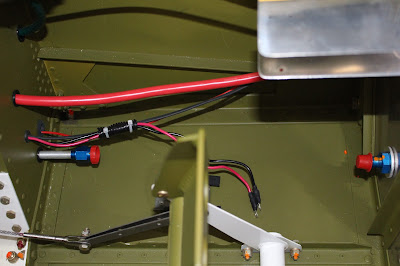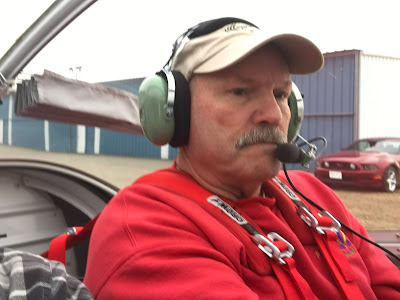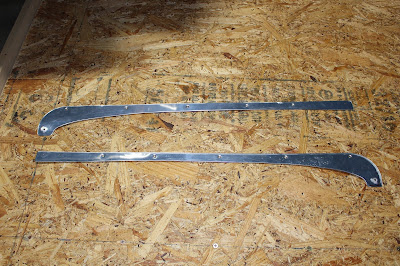I'll start this post by resolving the cliffhangers: The brake system was refilled, bled several times and tested several times. All tests were successful. I can finally cross that task off the list.

Grove Airfoil Gear Fitting Test 4
The next thing to test was the Airflow Specialties fuel boost pump. This was another test I was dreading. During the first electrical testing in April of 2019 the boost pump switch was briefly tested; the pump did not turn and the circuit breaker popped. I learned two things: the pump should never be tested dry and the fuel system should be thoroughly flushed with fuel before attempting to run the pump. The inside of the pump is coated with a preservative prior to shipping; this preservative can gum up the pump and prevent it from turning. Other builders have burned out their pumps because of this. I prayed I hadn't done the same thing as I prepared for the flow tests. The system had been flushed out back in August; fuel was run through the plumbing for each wing tank and out the firewall hose and the fuel was discolored by dissolved preservative. I bought two more 5 gallon fuel cans and a parcel scale that would allow me to weigh the cans precisely before, during and after testing. Using a formula extrapolated from my engine documentation and the tests performed by other builders, I calculated the maximum rate of fuel flow the engine would require at full throttle and added a 25% safety margin to determine the minimum flow rate for the pump to provide. I made up a 20' ground strap with large clips at each end and attached the clips to the engine ground cable and a bolt sunk into the hangar floor. One of the aluminum flushing tubes was fitted to the firewall-forward fuel hose and routed into one of the fuel cans, resting on top of the scale. I hoped for the best while a fuel truck added exactly five gallons of 100LL fuel pumped into each tank and I set up for the first official test of the boost pump. With Dave Pohl observing at the firewall, I turned on the master switch, pushed in the boost pump circuit breaker and flipped the boost pump switch on. The pump didn't turn and the breaker popped. So much for testing the pump today. Turned everything off; disconnected the tubing and capped the hose.
Another dread became reality: now I had to remove the boost pump. It had been much easier to deal with earlier in the build without that pesky forward top skin riveted in place. Now it could only be accessed through the footwell or the forward baggage door. Fortunately I was able to set up a work light in the space and squeeze through the baggage door to disconnect the fuel tubes, unclamp the boost pump, disconnect the wires and remove the boost pump. The small amount of fuel spillage in the footwell was contained with plastic lids and cleaned up. It came out easier than I expected; now I had to figure out what to do with it. I tested the voltage at the pump wires and got the same result as I had when the pump was originally installed; no problem with power. The warranty had expired a long time ago and was further voided when I disconnected the wires to get it out. Other builders that had faced this issue had to replace the pump but a replacement cost $410. I wasn't going to spend that kind of money without checking into other options. I asked around to see if any local shop would service the pump and got no leads, so I called Airflow Performance and described my situation with full disclosure. Much to my surprise, they told me to send the pump back to them; they would flush, inspect and test it and get it working again. This was a huge relief. I boxed it up and sent it off to their shop in Spartanburg, SC.
While the pump was being serviced a few more minor jobs were done. I wasn't happy with the current routing of the fuselage vent scat tube and rerouted it. I had received the custom stick brace adjustment tubes for my Ultimate Gust Lock from Anti-Splat Aero; they were installed and I practiced fitting the unit to the rudder pedals and stick. It was more awkward than I expected; when seated in the cockpit the pedals are out of sight behind the instrument panel and it takes some contortion to get the gust lock in place on the pedals. After a couple tries I was able to get it deployed and locked; I also practiced stowing it in the cockpit on the left side above the passenger footwell. I'll need to make up a canvas bag that will fit in the stowage space; Classic Aero Designs still had some of the canvas in stock that they used to make up my seats. They sent me a yard of material which will be enough for several cockpit pouches.
I want to give a shout out to Anti-Splat Aero and Airflow Performance here; their customer support has been excellent and they stand behind their products. Anti-Splat Aero supplied me with a custom part at no charge; they only asked that I return the unused stock parts. Airflow Performance shipped my refurbished pump back to me less than 48 hours after they received it. In both cases, all I had to pay was shipping costs. I'm a very happy customer and recommend them highly.
When I got the pump back I reinstalled it, reconnected the fuel lines and torqued and sealed the fittings. I spliced fully insulated blade connectors onto the pump wires, connected them and secured the wiring with flex conduit and zip ties. All the pre-test setup was performed and with my daughter Naomi watching up front, I tested the pump. It worked perfectly. I did timed flow tests from each tank with each fuel can on the scale. I botched the first timed test because I forgot to shut the fuel valve off after turning off the pump and fuel continued to siphon into the can; this threw off both the quantity and the timing numbers. The tests were repeated; pulling from each tank in two minute increments. The tanks went dry faster than I expected, and if my calculations are correct I'm very happy with the results. The pump is capable of providing much more fuel to the engine than it can consume and my fuel pickup tubes leave very little unused fuel in the tanks with the fuselage level. When the tests were completed, the testing equipment was disconnected and the tail was lowered back onto the ground. The fuel in the cans was poured back into the tanks (the newly regulated safety nozzles now supplied with all fuel cans now are incredibly annoying) and the tanks were topped off. All the numbers matched up; full tanks hold 21 gallons each. I knew the tanks would have to be emptied before the finished aircraft was weighed, but I'd worry about that later. I needed to be sure that I had no leaks and I wanted the tanks full while the aircraft sat through the winter months to prevent condensation from collecting in the tanks. Which reminds me... I need to test the fuel sumps; I hope they don't start leaking. Testing the fuel system on a new experimental aircraft can be scary sometimes. When I empty the tanks again I will perform more fuel flow tests to verify my initial results.
It's time to address the current engine situation. Ever since I returned the engine to Barrett in April I have checked in with Rhonda every few weeks for updates. I haven't bothered trying to contact Superior and they have never bothered to contact me. As time passed I heard various rumors; the AMOC was supposed to be submitted in April; it was supposed to be submitted after OSH AirVenture; etc. All Superior kept saying is "we're very close to approval". On September 2, Superior Air Parts VP of Customer Support Bill Ross told Rhonda that he and the President of Superior met with FAA representatives in person that day; they made some final revisions to the AMOC and submitted it. They were confident that it would be quickly approved. I thought that was very good news at the time; surely I would hear of the FAA approval within their allotted 45 day response time. As that time passed, my engine was disassembled and found to be in very good condition and Superior supplied Barrett with all the other parts required for the engine rebuild. The deadline came and went; in mid-October I sent Rhonda a query. She sent another email to Bill Ross and got the following response:
We are very close. Hopefully in the next couple of weeks. All edits have been made to the AMOC as requested by our DER (?) and now awaiting approval. Bill Ross, VP of Product Support.
I had no idea what was actually being said here. I thought the edits were made and the AMOC was submitted on September 2. To what edits is he referring? Who is "our DER"? When was the AMOC actually submitted, and were further edits required after submission? Rhonda had no other information to offer other than the possibility that Superior has a challenging relationship with the FAA that was created several years ago by a former Superior representative. Superior has spent a lot of time trying to cultivate a better relationship with the FAA but seems to be struggling with getting approvals through. In the meantime, all engine owners affected by the AD are left to swing in the breeze. This was getting me nowhere, so I reached out the FAA Airworthiness Directive division via email and explained my plight in detail. Within hours, I received the following response:
I am sorry to hear you are having difficulties. Unfortunately we can't release AMOCs or any of their information to anyone other than the requestor (OEM/Authority if it is Global). You may use the contact listed in the AD (Justin Carter's email address) if you would like further assistance.
I sent another detailed email to Justin Carter at the Ft. Worth Aircraft Certification Office and was again surprised by an immediate response:
I can not confirm that Superior has submitted and AMOC yet, but Bill Ross sent me an email Thursday indicating that a formal AMOC is in the mail.
Ok, now I'm mad. Superior has been lying to us for almost a year now; as far as I am concerned they can no longer be trusted. We're still hanging in the breeze and have no way of reliably determining whether there will ever be a resolution to to this situation. I asked Rhonda if replacement crankshafts were available; she said they were and she had one in stock. After conferring with Amy and seeking the advice of others, I committed to buying a replacement crankshaft for $7000. I don't have the money to pay for it yet, but when payment is due I'll scramble to come up with it somehow. There just seemed no point in continuing to hang in limbo any longer. Either I get this engine rebuilt and get the airplane flying, or I bail on building, sell everything off, turn my back on aviation and be a miserable failure for the rest of my life. I gave Rhonda the green light and the shop was able to get started on the rebuild right away. The engine could be ready as soon as next week; we'll see how this all plays out.
This should be good news, but it doesn't feel like it. I know that the current compensation Superior is offering to those that opt to buy their own replacement crankshafts is far from acceptable. I know what I'm going to demand from them; it will not be unreasonable and I'm trying to hope that we can settle it without getting lawyers involved. Superior has shown some bad faith in the way they've handled this; I'm sure Bill Ross knows that, but I'm betting that his hands are tied by new corporate ownership. Their reputation has been badly damaged by this issue. I'm hoping they'll understand that when we discuss a settlement.
**********
There's no easy way to transition into what needs to be stated at this point in this blog.
**********


**********
At 12:05 p.m. on Friday, November 5, 2021 Amy and I had just left the house, heading north to celebrate her birthday in Traverse City when I received a phone call from Dave Pohl. Earlier that morning my DAR, mentor and our close friend Ted Gauthier was killed when his RV-6 lost power over Clare County, MI; the forced landing was not successful. To state that this was a tremendous gut punch to my soul would be a vast understatement. Ted was one of my biggest sources of encouragement as my build progressed into the steep slopes approaching completion. Ted was a Renaissance Man and a force of nature; anyone who knew him knew that. He was a highly intelligent, highly motivated person with a heart of gold; a firefighter, EMT, business owner, balloon pilot, aircraft builder, boat builder, craftsman, examiner, helper, motivator; a wealth of knowledge and someone with a knack for inviting the people he met into his realm of true and welcoming friendship. He left us all way too soon, but I can guarantee you that everyone who knew him and grieves his loss will carry his lessons forward as we use them to better ourselves and our achievements. He would want nothing less, and he would be honored by our efforts to continue his legacy in this way. As time progresses, I will strive to learn the lessons that can be learned by his untimely death; I will examine any information gathered in the investigation of his crash and use it as a valuable learning tool that may, in the future, help me to avoid his fate. This is what pilots do, in any case; we learn from the mistakes of others because those mistakes are often fatal. We strive to benefit from their sacrifice, using them as a resource to avoid our own errors that could lead to our own death and the loss and bereavement felt by our family, friends and fellow pilots. Ted would want nothing less. If he could help us in any way, even after death, he would want that. I will remember that to my own dying day, and strive to follow his example. Thank you for that, Ted, and for all the wisdom and friendship you shared while you were here. I will never forget...


**********
Since that fateful day, my fire has died down; winter is coming and the wind is blowing cold. I've tried to keep going and managed to achieve a few things of note. I've continued to work on the empennage fairing; trimming and shaping the aluminum lower fairings; match drilling and the aftmost holes through the fairings, inspection covers and longerons before tapping the longeron holes for 6-32 threads. The empennage fairings were brought back to the shop. The aluminum parts were cleaned, wash primed and primed before the shop paint booth was dismantled and the shop cleaned right before the first snowfall.
I will admit to walking around in a bit of a fog for the past week, soaking in sadness and discouragement. This has been such a long hard journey for me... far harder than I ever expected. But I promised myself early on that I would not give up until my aircraft flies. When we lost Ted, I lost my DAR; this was a big blow in itself. Although we hadn't formally begun the Airworthiness Inspection process Ted had made notes of my progress and granted permission for closure on some areas after he inspected them. DARs for experimental aircraft are hard to come by; Ted was the only one available in MI when he left us. I did a lot of research and finally found a DAR in the Cleveland area that was willing to come up to my location to perform an inspection on my aircraft. I look forward to working with Matthew Tomsheck; he has a good reputation in the aviation community and a wide range of experience.
I attended Ted's funeral yesterday and the reception afterward. I'm normally averse to funerals (who isn't?) and usually find reasons not to attend, but I'm glad I went to this one. I learned a lot more about Ted that I hadn't known and found it very inspiring. I think I'm ready to start looking forward again. The engine should be done soon and I have to decide whether to have it delivered or make the journey to Tulsa to pick it up. At least it's a win-win decision. I can continue to work on the fiberglass bits in the shop, refining the wheel and intersection fairings and getting them ready for paint. I still have to figure out a way to install the nut plates in the aft top skin for the empennage fairings. I can start to work on the cockpit pouches and apply the last of the required placards. I can get the firewall forward area ready to accept the engine again and prepare for the remount. I have sold off some of the jigs and fixtures I've accumulated that I won't use again and have buyers for what remains. Susan Kuntzman was kind enough to lend me some heaters for the hangar that I need to set up. So there's lots I can still do... and I should get back to work. Stay Tuned...



















































